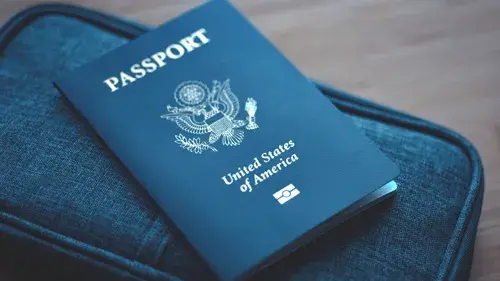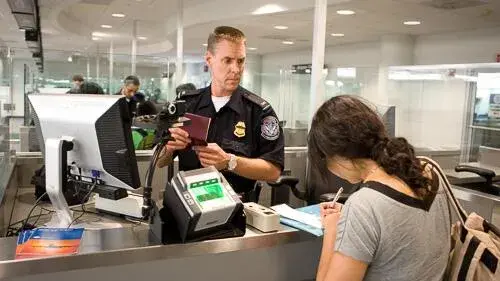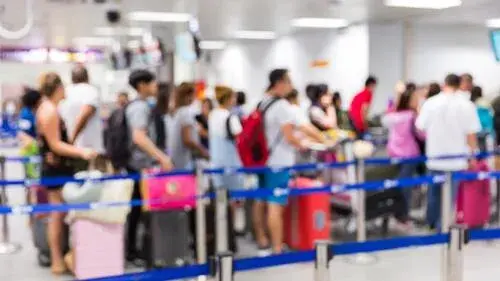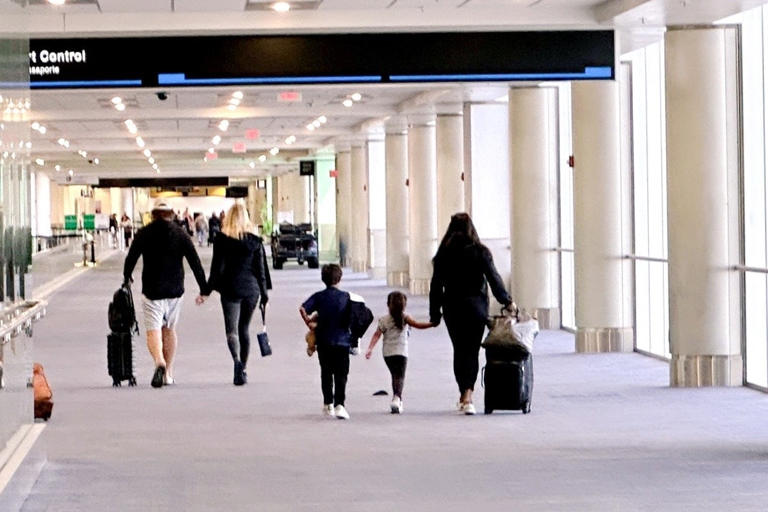You must turn on JavaScript in order to use this website.
You are using an outdated browser and some features of this website may not work correctly. Please upgrade your browser to improve your experience.

An official website of the United States government
Here’s how you know

Official websites use .gov A .gov website belongs to an official government organization in the United States.
Secure .gov websites use HTTPS A lock ( Lock A locked padlock ) or https:// means you’ve safely connected to the .gov website. Share sensitive information only on official, secure websites.

- For U.S. Citizens/Lawful Permanent Residents
- Know Before You Go

Before Your Trip
Booking your tickets.
Match Names on Tickets and Documents
Purchase your travel tickets in the exact same name that appears on your passport or official ID. Ensure that all travel documents match that name precisely.
If the names don't match, your travel carrier or the Transportation Security Administration may require additional documents to verify your identity before allowing you to board.
Each Country is Different
Learn the required travel documents for each country you will visit. Find out about specific travel warnings, U.S. import restrictions, and other rules that apply to the countries on your itinerary by visiting www.state.gov/travelers .
Find the latest on making your return to the United States problem free - go to www.cbp.gov/travel .
Documents You Will Need
Carry - do not pack - all travel documents.
- All U.S. citizens need U.S. passport books if re-entering by air. Land and sea border crossings accept additional travel documents, such as U.S. Passport cards and Trusted Traveler cards. Child travelers have additional options - see the Traveling with Children section.
- Green card (Form I-551), or document for lawful permanent residents, or advance parole (Form I-512) if your Form I-551 is pending.
- A visa or other entry document for the countries you will visit.
- Receipts or registration ( CBP Form 4457 ) for new electronics, such as a camera or laptop, that you are taking abroad. (Only suggested if the goods are less than six months old.)
- Proof of rabies vaccination for dogs traveling abroad. Check the requirements for other pets at www.aphis.usda.gov .
- Valid license for driving overseas and for use as a second form of photo ID.
- Permits and/or certificates if bringing restricted animal or plant products - go to www.aphis.usda.gov .
- Medications in their original packages. Bring only the amount of medication you will need. Prescription medications have to be under the traveler's name.
- Envelope to hold the receipts of your purchases abroad.
Traveling with Children
When U.S. citizen children under the age of 16 arrive by land or sea from Canada or Mexico they may present an original or copy of their birth certificate, a Consular Report of Birth Abroad, or a Naturalization Certificate.
Groups of Children: U.S. citizen children under the age of 19 arriving by land or sea from Canada or Mexico and traveling with a school group, religious group, social or cultural organization or sports team, may present an original or copy of their birth certificate, a Consular Report of Birth Abroad, or a Naturalization Certificate. The group should have a letter on organizational letterhead with:
- The name of the group and supervising adult(s).
- The names of the children on the trip and their primary address, phone number, date and place of birth, and name of at least one parent or legal guardian for each child.
- A written and signed statement of the supervising adult certifying that he or she has parental or legal guardian consent for each child.

An official website of the United States government
Here’s how you know
Official websites use .gov A .gov website belongs to an official government organization in the United States.
Secure .gov websites use HTTPS A lock ( Lock A locked padlock ) or https:// means you’ve safely connected to the .gov website. Share sensitive information only on official, secure websites.
For Travelers
Apply for a U.S. passport, check wait times, information on crossing U.S. borders, file a travel complaint (DHS TRIP), find overseas travel alerts, join frequent traveler programs, learn what you can bring on a plane, locate a port of entry (air, land, or sea), travel overseas, and visit the United States.
Apply for a U.S. Passport

DHS provides information on the passport application process, obtaining a visa, border crossing documents, and general travel tips.
Check Wait Times

Transportation Security Agency (TSA) and Customs and Border Protection (CBP) provide information on wait times at airports and border crossings.
Cross U.S. Borders

Travelers traveling through the U.S. must have the required documents needed to enter based upon their citizenship or place of residence.
File a Travel Complaint (DHS TRIP)

The DHS Redress Inquiry Program (DHS TRIP) allows individuals to report difficulties about their security screening at transportation hubs or U.S. borders.
Learn What I Can Bring on the Plane

Learn what you can bring on the plane by reviewing TSA's list of what you can bring on the plane, what you cannot bring on the plane.
Locate a Port of Entry (Air, Land, Sea)

Locate a Port of Entry (Air, Land, Sea) when entering the United States.
Travel Overseas

Find answers to common questions from international travelers about planning for your trip, returning home and navigating passenger processing.
Trusted Traveler Programs (TTP)

TTP provides modified screening for pre-approved members by improving security by being more efficient during screenings at ports of entry.
Visit the United States

DHS provides a full range of online resources to help you plan your trip, manage your arrival and if needed extend your stay when visiting the U.S.

Green Card Renewal
Family-Based Green Card Petition
Employment Authorization Document
(EAD) - Form I-765
Deferred Action for Childhood Arrivals
(DACA) - Form I-821D
U.S. Citizenship Application
Citizenship Application
Certificate of Citizenship
Green Card Replacement
Lost or Stolen Green Card
Green card for Husband or Wife
Green card for Child
Green card for Parents
Green card for Sibling
Green Card Through Employment Application
Application for Travel document
Family-Based Green Card
Adjustment of Status application
Affidavit of Support
Forms I-134
Forms I-864
Remove Conditions on Green Card
Employment Authorization Application
Petition for Fiancé(e) Visa - K-1 Visa
Form I-129F
Change/Extend Nonimmigrant Status
U.S. Citizenship Test
Medical Exam
National Visa Center
Uscis Offices
Uscis Case Status
Uscis Infopass
Uscis Processing Times
U.S. Immigration News
U.S. Immigration Blog
U.S. Travel Documents Requirements: Traveling to and from the USA

If you are planning a trip to or outside the U.S. , the first thing you need to make sure is that your travel documents are in order . A travel document is a form of identification issued by a government to ease the movement of individuals across international borders. Before you leave for the airport, you need to make sure that your travel document is valid , and that you have all the necessary extra documentation , including any required visas . There are different types of travel documents that are issued based on immigration status and purpose for the trip . U.S. law requires that every individual , regardless of citizenship, age or destination, needs to hold a valid travel document(s) to travel outside of the United States. Of course, the requirements for crossing international boundaries vary depending on the country of destination. It is paramount when traveling either domestically or internationally to make sure you have the necessary travel documents, required visas, for entering or departing the United States.
Main Travel Documents
It is important to keep in mind that the travel document requirements for traveling outside of the U.S. may not be the same required to enter another country. The main travel documents issued by the U.S. government are passports, U.S. permanent resident card (Green Card), R efugee or Stateless travel document , Re-Entry Permit , and emergency travel document issued by an embassy or consulate. But what are the differences between them?
The passport is perhaps the most common travel document there is. It is usually issued in a booklet format. It has a biometrics page with the holder’s information and also blank pages for entry and departure stamps and visas . It acts as a form of identification and proof of citizenship . Most countries require that a passport is valid for at least 6 months at the time of arrival.
The governmental entity responsible for issuing passports in the U.S. is the Department of State (DOS). U.S. passports act as proof of U.S. citizenship and allow their holder entry into a total of 156 countries visa-free.
Passport Cards
Both apassport and passport card are considered U.S. passports . They both serve as proof of your U.S. citizenship and identity. The passport card is a wallet-sized travel document that can only be used by U.S. citizens to re-enter the United States at land border-crossings or ports-of-entry by sea from Canada, Mexico, the Caribbean, and Bermuda. This card is a smaller, more convenient, and less expensive alternative to the traditional passport, especially for those who frequently travel to these destinations. The passport card, like the passport book, is valid for 10 years for an adult, and five years for children age 16 and younger. If you already have a passport book, then you may apply for the passport card at a reduced price.
USA Travel Documents
Form i-94 and arrival/departure records.
Form I-94, Arrival-Departure Record , is used to record traveler's’ arrival/departure information to the United States . However, CBP now gathers this information automatically from their electronic travel records. All those arriving in the U.S. via air or sea are no longer required to complete Form I-94 Arrival/Departure Record . However, if they need the information from their Form I-94 admission record to prove their legal-visitor status, they can access their arrival/departure record information online. Because CBP only collects this information automatically for air and sea travelers, CBP will still issue a paper form I-94 at land border ports of entry.
To travel to and enter the United States, travelers need a visa . The type of visa you will need to apply for depends on the reason for your visit. You can apply for a visa at a U.S. embassy or consulate in your country of residence. Your approved visa will be placed on directly in your passport . A visa usually comes in either a stamp or loose piece of paper format and shows the purpose of your trip as well as its validity. You cannot enter the U.S. after your visa’s expiration date. At the port of entry, the DHS officer will enter the date when you are required to leave the U.S in your I-94 form. You have an obligation to leave the United States by this date since it is when your immigration status expires, or face not being allowed to re.-enter the U.S. even if you have a valid travel document.
In addition to the traditional visas, the USCIS also issues three types of travel documents for exceptional circumstances. These special travel documents allow their holders to re-enter the U.S. country without having to apply for a visa. To apply for these travel documents, individuals need to complete and file Form I-131, Application for Travel Document and choose which document they want to apply for:
- An advance parole document
- A refugee travel document
- A re-entry permit
All those who applied for asylum or were considered asylees on or after April 1, 1997, can lose their status should they return to the country for which they sought asylum.
Advance Parole
Individuals who are in the process of adjusting their status or applying for an immigrant visa (refugees and asylees) are required to apply for advance parole document. Failure to do so can lead to severe consequences upon returning and trying to enter the United States, as these individuals may be found inadmissible, their applications may be denied, or both. It is paramount for non-U.S. citizens to obtain the proper documentation before leaving the United States . However, there are three exceptions to the requirement for nonimmigrant visa holders to apply for advance parole: H1B, L and K3/4 holders as well as their dependents. Those who hold a K1/2 visa and who have married a U.S. citizen must apply for legal permanent resident (Green Card holder) status and advance parole before leaving the United States, by filing Form I-131.
Non-immigrant visa holders must obtain Advance Parole, before departure, to re-enter the United States if they have:
- Filed an application for adjustment of status but have not received a decision from the USCIS;
- Hold refugee or asylee status and intend to depart temporarily to apply for a U.S. immigrant visa in Canada; and/or
- An emergency or personal reason to travel temporarily abroad.
Refugee Travel Documents
The USCIS grants refugee travel documents to i ndividuals with refugee or asylum status and to lawful permanent residents who obtained their Green Cards based on their refugee or asylee status. If you want to travel abroad, you will need a passport. A refugee travel document is the equivalent of a passport for asylees and refugees who need to travel outside the U.S. temporarily. Before traveling abroad , those who were granted asylum or refugee status must apply for a refugee travel document . Family members who are classified as derivative asylees or refugees must also apply and obtain a refugee travel document before traveling outside of the United States. Failing to get a refugee travel document before leaving the U.S. could have serious consequences like being denied re-entry into the U.S. or even being deported. It is also important to keep in mind that both asylees and refugees you should never travel to the country from which they claimed persecution.
Re-entry Permits
A reentry permit allows a permanent resident (Green Card holder) or conditional resident to apply for re-entry after having spent at least a year outside of the United States. Those who are granted a re-entry permit are not required to apply for a returning resident visa from a U.S. embassy or consulate.
If you are a U.S. lawful permanent resident (green card holder) , and you need to spend a year or more outside the United States, you are required to get a re-entry permit to maintain your status. While Green Card holders are allowed to travel, they cannot spend more than an allotted time outside the U.S. running the risk that immigration authorities may consider the act an intent to abandon U.S. residence status . A re-entry permit helps prove that you did not mean to give up your status . A re-entry permit is also useful for when you cannot, or do not wish to, get a passport from your home country. The permit (which looks like a passport) can be used in its place. Remember that you cannot extend the time on your re-entry permit. If it expires, and you want to renew it, you will need to return to the U.S. and apply for a new one.
Emergency Travel
In the case of emergency, and before leaving the United States , the USCIS might process an application for a travel document faster . If you are experiencing an extremely urgent situation, you may visit your local office to request an emergency travel document. You will be required to submit any additional documentation required, including proof of your emergency situation , e.g.; medical documents, death certificates, travel records, etc. It is important to understand that business trips, weddings, holiday parties and other planned events are usually not considered emergency situations. USCIS considers emergency situations to be, life-threatening conditions, a humanitarian situation like a natural catastrophe. Your requested assistance to attend a cultural or social program which would benefit the United States, etc.
So if you are a foreign national planning a trip outside of the U.S., please make sure you have all the appropriate travel documents in order or risk losing their rights and benefits given to you by the U.S. government. Failing to do so may result in being found inadmissible upon your return, or your applications may be denied, or both. That is why it is paramount that the proper documentation is obtained before leaving the United States .
Previous Post Next Post
You may also like

There are only 4 documents that have been approved by U.S. immigration services. Find out which documents prove that you are an american citizen.

Recommended
- U.S. Citizenship
- Citizenship Application (N-400)
- Certificate of Citizenship (N-600)
- Green Card Renewal (I-90)
- Family-Based Green Card (I-130)
- Employment Authorization Document (I-765)
- Deferred Action for Childhood Arrivals - DACA (I-821D)
- All Immigration Forms
- Privacy policy
- Refund policy
- Terms and conditions
- Travel Planning Center
- Safer Travel
- Airline Partners
- Check-in & Security
- Delta Sky Club®
- Airport Maps & Locations
- Flight Deals
- Flight Schedules
- Destinations
- Onboard Experience
- Delta Cruises
- Delta Vacations
- Shop Hotels
- In-Flight Wi-Fi
- Trip Protection
- How to Earn Miles
- How to Use Miles
- Buy or Transfer Miles
- Travel with Miles
- SkyMiles Partners & Offers
- SkyMiles Award Deals
- SkyMiles Credit Cards
- SkyMiles Airline Partners
- SkyMiles Program Overview
- How to Get Medallion Status
- Benefits at Each Tier
- News & Updates
- Help Center
- Travel Planning FAQs
- Certificates & eCredits
- Accessible Travel Services
- Child & Infant Travel
- Special Circumstances
- SkyMiles Help
Travel Within the U.S.
In the United States, you need a valid U.S. government-issued photo ID or a passport from your country of origin to travel through security. You must show that the name on your boarding pass matches the legal name on your unexpired government-issued ID.
Acceptable forms of ID include
Driver's License
Military ID
Other Government-Issued Photo ID Card
See TSA Guidelines for Travel Documents
- Investor Relations
- Business Travel
- Travel Agents
- Comment/Complaint
- Browser Compatibility
- Accessibility
- Booking Information
- Customer Commitment
- Tarmac Delay Plan
- Sustainability
- Contract of Carriage
- Cookies, Privacy & Security
- Human Trafficking Statement (PDF)
Official websites use .gov A .gov website belongs to an official government organization in the United States.
Secure .gov websites use HTTPS A lock ( A locked padlock ) or https:// means you've safely connected to the .gov website. Share sensitive information only on official, secure websites.
- Create Account
International Travel as a Permanent Resident
In general, you will need to present a passport from your country of citizenship or your refugee travel document to travel to a foreign country. In addition, the foreign country may have additional entry/exit requirements (such as a visa). For information on foreign entry and exit requirements, see the Department of State’s website .
If seeking to enter the United States after temporary travel abroad, you will need to present a valid, unexpired “Green Card” (Form I-551, Permanent Resident Card). When arriving at a port of entry, a U.S. Customs and Border Protection Officer will review your permanent resident card and any other identity documents you present, such as a passport, foreign national I.D. card or U.S. Driver’s License, and determine if you can enter the United States. For information pertaining to entry into the United States, see U.S. Customs and Border Protection’s webpage .
Permanent residents are free to travel outside the United States, and temporary or brief travel usually does not affect your permanent resident status. If it is determined, however, that you did not intend to make the United States your permanent home, you will be found to have abandoned your permanent resident status. A general guide used is whether you have been absent from the United States for more than a year. Abandonment may be found to occur in trips of less than a year where it is believed you did not intend to make the United States your permanent residence. While brief trips abroad generally are not problematic, the officer may consider criteria such as whether your intention was to visit abroad only temporarily, whether you maintained U.S. family and community ties, maintained U.S employment, filed U.S. income taxes as a resident, or otherwise established your intention to return to the United States as your permanent home. Other factors that may be considered include whether you maintained a U.S. mailing address, kept U.S. bank accounts and a valid U.S. driver’s license, own property or run a business in the United States, or any other evidence that supports the temporary nature of your absence.
If you plan on being absent from the United States for longer than a year, it is advisable to first apply for a reentry permit on Form I-131 . Obtaining a reentry permit prior to leaving the United States allows a permanent or conditional permanent resident to apply for admission into the United States during the permit’s validity without the need to obtain a returning resident visa from a U.S. Embassy or Consulate abroad. Please note that it does not guarantee entry into the United States upon your return as you must first be determined to be admissible; however, it will assist you in establishing your intention to permanently reside in the United States. For more information, see the Travel Documents page.
If you remain outside of the United States for more than 2 years, any reentry permit granted before your departure from the United States will have expired. In this case, it is advisable to consider applying for a returning resident visa (SB-1) at the nearest U.S. Embassy or Consulate. An SB-1 applicant will be required to establish eligibility for an immigrant visa and will need a medical exam. There is an exception to this process for the spouse or child of either a member of the U.S. Armed Forces or civilian employee of the U.S. Government stationed abroad on official orders. For more information on obtaining a returning resident visa, see the Department of State’s webpage on returning resident visas .
Additionally, absences from the United States of six months or more may disrupt the continuous residency required for naturalization. If your absence is one year or longer and you wish to preserve your continuous residency in the United States for naturalization purposes, you may file an Application to Preserve Residence for Naturalization Purposes on Form N-470. For more information, please see the Continuous Residence and Physical Presence Requirements page.
If you lose your Green Card or reentry permit or it is stolen or destroyed while you are abroad, you may need to file a Form I-131A, Application for Travel Document (Carrier Documentation) . This carrier documentation will allow an airline or other transportation carrier to board a lawful permanent resident bound for the United States without the carrier being penalized. For more information, please see the Form I-131A, Application for Travel Document (Carrier Documentation) page.
More Information
- Welcome to the United States: A Guide for New Immigrants (PDF, 3.57 MB)
- How Do I Get a Reentry Permit? (PDF, 667.32 KB)
- I-131, Application for Travel Document
- I-90, Application to Replace Permanent Resident Card
Other USCIS Links
- Green Card Resources
- How Do I Help My Relative Become a Lawful Permanent Resident? (PDF, 577.38 KB)
- How Do I Renew or Replace My Permanent Resident Card? (PDF, 550.19 KB)
- "How Do I" Guides for Permanent Residents

Don't want to pay for Global Entry? The Mobile Passport Control app is fast, free and easy to use
I f you get my travel tips via my newsletter , then you know how much I dislike waiting in long lines. Who doesn’t? Since I travel so much with my family, we (me, my wife and our two kids) are members of all the pre-screened expedited programs: Global Entry, NEXUS, TSA PreCheck and Clear. RELATED: The trick to getting TSA PreCheck fast and 4 other tips you need to know
However, Global Entry isn’t free and sometimes there's a lengthy approval process. So if you rarely travel internationally (especially if you’re traveling as a family), it’s not worth paying for or taking the time to apply. However, some premium credit cards do pay for the application fee .
The next best thing to Global Entry is the CBP Mobile Passport Control (MPC) app and it’s free.
Mobile Passport Control allows eligible travelers to submit their travel document, photo, and customs declaration information through a free, secure app on their smartphone or other mobile device. Per the CBP’s website : “The use of MPC streamlines the traveler’s entry process into the United States by reducing passport control inspection time and overall wait time.”
Here’s how MPC Works:
This is straight from the CBP’s website: “After downloading the MPC Application from the Google Play Store or Apple App Store , eligible travelers will be prompted to create a profile with their passport or LPR [Lawful Permanent Resident] card information.” They're both highly rated apps. In the Apple app store, it has 4.9 rating with over 214.5K reviews. In the Google Play store, it has 4.8 rating with over 45.7K reviews.
Preclearance travelers
I find the MPC’s definition a little bit confusing because they say: “Upon arrival at eligible Preclearance locations users must select their mode of entry in the application as "Preclearance" before selecting their departing Preclearance Port of Entry.”
I don’t think many Americans realize that the United States government has set up customs pre-clearance for travelers heading to the U.S. in 15 locations: Dublin and Shannon in Ireland; Aruba; Bermuda; Abu Dhabi in the United Arab Emirates; Nassau in the Bahamas; and Calgary, Toronto, Edmonton, Halifax, Montreal, Ottawa, Vancouver, Victoria, and Winnipeg in Canada.
Arriving on U.S. soil
MPC then states: “If a traveler is not using preclearance, upon landing in the United States, travelers will select "U.S. airport" as their mode of entry and then select their arrival airport or seaport and terminal. Travelers will then take a self-photo and answer a series of CBP inspection-related questions. Once the traveler submits their transaction through the app, travelers will then bring their physical passport to a CBP officer to finalize their inspection for entry into the United States.”
Note: Cellular or Wi-Fi connectivity is required to send information, but travelers may complete profile(s) without being connected to the internet.
Who is eligible?
The MPC mobile app is available to U.S. citizens, U.S. lawful permanent residents, Canadian B1/B2 citizen visitors and returning Visa Waiver Program travelers with approved ESTA. MPC is currently available at 33 U.S. International Airports, 13 Preclearance locations, and 4 seaports of entry.
Visa Waiver Program (VWP)
The Visa Waiver Program (VWP) permits citizens of participating countries to travel to the United States for business or tourism for stays of up to 90 days without a visa. Below are the 41 countries participating in the Visa Waiver Program: Andorra, Australia, Austria, Belgium, Brunei, Chile, Croatia, Czech Republic, Denmark, Estonia, Finland, France, Germany, Greece, Hungary, Iceland, Ireland, Israel, Italy, Japan, Korea, Latvia, Liechtenstein, Lithuania, Luxembourg, Malta, Monaco, Netherlands, New Zealand, Norway, Poland, Portugal, San Marino, Singapore, Slovakia, Slovenia, Spain, Sweden, Switzerland, Taiwan and the United Kingdom.
Since I have Global Entry (GE), I’ve never used it but I have downloaded it since my friends and colleagues have used it and love it. I've also seen some good reviews on Facebook:
Chelsea Daniels on April 18, 2024 posted to Facebook: “Mobile Passport helped me get through O’Hare customs in 5 minutes which is highly uncommon.”
Travel writer Fred Sherman posted on the SATW Facebook page in 2022: “I just returned from my first international trip taken after I stupidly let my Global Entry expire and lapse. While waiting for GE renewal, I used the US CBP Mobile Passport Control app at LAX on Friday. It took two minutes to download the app and list myself as a traveler and then produce the CBP receipt. On arrival, although the entry hall was packed, I was the ONLY ONE in the MPC line and walked right up to the officer, and then out to baggage claim.”
Jorge Vega on April 11, 2024 on Facebook : I used it in Toronto and it was better than global entry. My flight was from Rome to Toronto and then to Phoenix with Air Canada.
Karen Kallet, April 8, 2024: Good to know: Mobile Passport Control app. If you are American or Canadian and do not have US Global Entry back to the US. This is the app that allows you to by pass the long immigration lines. I used it coming back from Vancouver. Worked like a charm. Even had a big sign with MPC at immigration to US. Own line, no one waiting. Once I arrived at the airport, I submitted the pre done info and got a QRCode. Showed my QR code and passport and it was very simple. Works for cruise ships, airports and preclearance. Which is what I used as I pre cleared in Vancouver for the flight to the states.”
I have some friends who are Global Entry members but use Mobile Passport Control when the Global Entry lines are long. That’s why I’ve downloaded the app, just to be ready.
Here’s a video showing you exactly how to use the Mobile Passport Control app:
Watch the video here .
Have you used MPC before? What’s it like and have you ever used MPC over Global Entry?
KEEP READING:
- 12 passport tips that will save you time, money and headaches
- The most important thing I do when I travel internationally is ...
- Rick Steves got pickpocketed in Paris: Here’s what he wants you to know
- The most important thing for travelers to do according to a safety expert
- What you need to know about renewing or getting an emergency passport in the U.S.
Want more travel news, tips and deals? Sign up to Johnny Jet’s free newsletter and check out these popular posts: The Travel Gadget Flight Attendants Never Leave Home Without and 12 Ways to Save Money on Baggage Fees . Follow Johnny Jet on MSN , Facebook, Instagram , Pinterest , and YouTube for all of my travel posts.

You asked: Do I need a passport for my cruise?
By The Way Concierge digs into the (surprisingly) complicated rules for travel by sea.

Traveling has always come with complications. Our By The Way Concierge column will take your travel dilemmas to the experts to help you navigate the unexpected. Want to see your question answered? Submit it here .
We’re going on a very short cruise from California to Mexico this spring. Do we need passports for our kids, even if we don’t get off the ship? — Ben, Springfield, Va.
There’s a difference between what you need and what is a good idea to have.
Let’s begin with the first: On most cruise lines and for most itineraries, a voyage that starts and ends at the same U.S. port and stays in the Western Hemisphere will not require any American citizen — child or adult — to have a passport.
These are called closed-loop cruises, and they only need proof of citizenship, such as a birth certificate plus a government-issued photo ID, according to U.S. Customs and Border Protection . For people under 16, a birth certificate will suffice. Popular cruise lines including Carnival , Royal Caribbean and Norwegian detail their requirements and any exceptions online.
A sailing that leaves from one U.S. port and ends at another — or starts in the United States and ends at a foreign destination — would not be classified as a closed-loop cruise. Everyone, including kids, would need a passport in that case.
There are some caveats, warns Teresa Tennant, senior vice president of the travel planning company Cruise Specialists . Some cruise companies, including Holland America Line and Princess Cruises , say that all members of a party must have a passport if minors are traveling with only one adult.
Some other cruise lines, such as the luxury Regent Seven Seas Cruises, require a passport for all sailings.
“It’s important to always check with the cruise line, because they can set their own rules that are actually above and beyond,” Tennant said.
Customs and Border Protection also urges travelers to check with their cruise company, travel agent and destination to confirm what’s required to enter foreign countries on an itinerary.
Whether or not you are required to have a passport, cruise lines and experts say it’s smart to have one before setting sail. The task isn’t quite as onerous as it used to be, now that wait times have returned to pre-pandemic norms of six to eight weeks for routine service and two to three weeks for the expedited process.
Cruise lines say they strongly recommend that passengers opt for the passport over other forms of identification.
“A passport is the hassle-free, gold standard for traveling between countries,” Royal Caribbean says on its website. “Boarding and disembarking through customs with a passport is usually faster than other types of ID documents.”
The U.S. State Department says travelers might need their passport “in the event of an unexpected medical evacuation or if the ship docks at an alternate port.” Travelers would also need their passports if they showed up late in a foreign port and the ship left without them — which has happened to some U.S. passengers recently.
“You should bring your passport even if your cruise says you won’t need it,” the State Department says on its information page for cruise ship passengers.
Colleen McDaniel, editor in chief of the news and review site Cruise Critic , said in an email that it would be much more difficult to get home without a passport if someone had to leave the ship.
“In such a case, you might have to rely on help from a U.S. embassy or consulate to return, which can take time,” she said.
Have a travel dilemma for By The Way Concierge? Send it to us here .
More travel tips
Vacation planning: Start with a strategy to maximize days off by taking PTO around holidays. Experts recommend taking multiple short trips for peak happiness . Want to take an ambitious trip? Here are 12 destinations to try this year — without crowds.
Cheap flights: Follow our best advice for scoring low airfare , including setting flight price alerts and subscribing to deal newsletters. If you’re set on an expensive getaway, here’s a plan to save up without straining your credit limit.
Airport chaos: We’ve got advice for every scenario , from canceled flights to lost luggage . Stuck at the rental car counter? These tips can speed up the process. And following these 52 rules of flying should make the experience better for everyone.
Expert advice: Our By The Way Concierge solves readers’ dilemmas , including whether it’s okay to ditch a partner at security, or what happens if you get caught flying with weed . Submit your question here . Or you could look to the gurus: Lonely Planet and Rick Steves .
- You asked: Do I need a passport for my cruise? 2 hours ago You asked: Do I need a passport for my cruise? 2 hours ago
- You asked: Do I have to pay an international parking ticket? March 21, 2024 You asked: Do I have to pay an international parking ticket? March 21, 2024
- You asked: Can I ditch my PreCheck-less partner at security? January 11, 2024 You asked: Can I ditch my PreCheck-less partner at security? January 11, 2024

Update April 12, 2024
Information for u.s. citizens in the middle east.
- Travel Advisories |
- Contact Us |
- MyTravelGov |
Find U.S. Embassies & Consulates
Travel.state.gov, congressional liaison, special issuance agency, u.s. passports, international travel, intercountry adoption, international parental child abduction, records and authentications, popular links, travel advisories, mytravelgov, stay connected, legal resources, legal information, info for u.s. law enforcement, replace or certify documents.
Tourism & Visit
Study & Exchange
Other Visa Categories
U.S. Visa: Reciprocity and Civil Documents by Country
Visa Information & Resources
Share this page:
Rights and Protections for Temporary Workers - Japanese
Rights and Protections for Temporary Workers - Turkish
Rights and Protections for Temporary Workers - Hebrew
Rights and Protections for Temporary Workers - Albanian
Rights and Protections for Temporary Workers - Tagalog
Rights and Protections for Temporary Workers - Russian
Rights and Protections for Temporary Workers - Polish
Rights and Protections for Temporary Workers - Ukranian
Visa Wizard
Visa Denials
Fraud Warning
What the Visa Expiration Date Means
Automatic Revalidation
Lost and Stolen Passports, Visas, and Arrival/Departure Records (Form I-94)
Directory of Visa Categories
Straight Facts on U.S. Visas
Customer Service Statement
Photo Requirements
Photo Examples
Digital Image Requirements
Photo Frequently Asked Questions
Photo Composition Template
Online Immigrant Visa Forms
DS-260 Immigrant Visa Electronic Application - Frequently Asked Questions (FAQs)
DS-160: Online Nonimmigrant Visa Application
DS-160: Frequently Asked Questions
Administrative Processing Information
Visa Appointment Wait Times
Nonimmigrants in the United States–Applying for Visas in Canada or Mexico
Frequently Asked Questions
Visa Applicants - State Sponsors of Terrorism Countries
What is a U.S. Visa?
About Visas - The Basics
Rights and Protections for Foreign-Citizen Fiancé(e)s and Spouses of U.S. Citizens and Spouses of Lawful Permanent Residents
Your Rights and Protections
Ineligibilities and Waivers: Laws
Rights and Protections for Temporary Workers
Advisory Opinions
Fees for Visa Services
Treaty Countries
Fees and Reciprocity Tables
Temporary Reciprocity Schedule
Country Acronyms
Reciprocity: What's New? 2019 Archive
Reciprocity: What's New? 2022 Archive
Reciprocity: What's New? 2020 Archive
Reciprocity: What's New? 2021 Archive
Reciprocity: What's New?
Reciprocity: What's New? 2023 Archive
Safety & Security of U.S. Borders: Biometrics
National Visa Center Customer Service Pledge
Americans Traveling Abroad
The United States and China Agree to Extending Visas for Short-term Business Travelers, Tourists, and Students
Special Visa Processing Procedures Pursuant to Section 306
Capitalizing on Visa Demand to Spur Economic Growth in the United States
Congressional Testimony
Cuban Family Reunification Parole (CRFP) Program Appointments
List of U.S. Embassies and Consulates - K1-K3 Visas
U.S. Government Fact Sheet on Female Genital Mutilation or Cutting (FGM/C)
Skill List by Country
Presidential Proclamation 9645 and the January 2020 Presidential Proclamation
Public Inquiry Form
List of U.S. Embassies and Consulates
Affidavit of Support Fee Refund
Immigrant Visa Prioritization
USCIS Extends Suspension of Premium Processing Service for Religious Workers (R-1) Nonimmigrant Visa Classification
Record Numbers of U.S. Students Are Studying Abroad
U.S. Student Visas Reach Record Numbers in 2007
U.S. security officials will begin scanning all 10 fingerprints of most non-Americans traveling to the United States
Electronic Submission of Diversity Visa Lottery Applications
USCIS Centralizes Filing for H-2A Petitions
USCIS Field Office Adopts Teletech Call Appointment System For Filing Waiver of Inadmissibility Applications
Application Fees for Non-Immigrant Visas to Increase on January 1, 2008
Senior Advisors to Brief Press on the Latest Developments in Iraqi Refugee and Special Immigrant Visa Issues
Briefing on Developments in the Iraqi Refugee and Special Immigrant Visa (SIV) Admissions Programs
DHS Proposes Changes to Improve H-2A Temporary Agricultural Worker Program
Testimony of Stephen A. “Tony” Edson on U.S. House of Representatives, Committee on Science and Technology Subcommittee on Research and Science Education, House Committee on Science and Technology
Update: Biometric Changes for Re-entry Permits and Refugee Travel Documents
With All the Talk about Illegal Immigration, a Look at the Legal Kind
Latvia, Estonia Sign Deals with US on Visa-Free Travel
Fact Sheet: Changes to the FY2009 H-1B Program
USCIS Announces Interim Rule on H-1B Visas
USCIS Releases Preliminary Number of FY 2009 H-1B Cap Filings
USCIS Extends Comment Period for Proposed Change to H-2A Program
USCIS Runs Random Selection Process for H-1B Petitions
17-Month Extension of Optional Practical Training for Certain Highly Skilled Foreign Students
DHS Begins Collecting 10 Fingerprints from International Visitors at Hartsfield-Jackson Atlanta International Airport
Hague Convention on Intercountry Adoption Enters into Force
USCIS to Accept H-1B Petitions Sent to California or Vermont Service Centers Temporary Accommodation Made for FY 09 Cap-Subject H-1B Petitions
USCIS Revises Filing Instructions for Petition for Alien Relative
USCIS Announces Update for Processing Petitions for Nonimmigrant Victims of Criminal Activity
USCIS to Allow F-1 Students Opportunity to Request Change of Status
Immigration Tops Agenda at North American Summit
USCIS Issues Guidance for Approved Violence against Women Act (VAWA) Self-Petitioners
USCIS Modifies Application for Employment Authorization Previous Versions of Form I-765 Accepted until July 8, 2008
Overseas Education More Attainable for Chinese Students
New York Business Group Seeks Fewer Restrictions on Foreign Worker Visas
Use only Internet Explorer 11 or higher, Firefox, or Google Chrome 58 when completing your application. Safari and Microsoft Edge are not supported.
The DS-160, Online Nonimmigrant Visa Application form, is for temporary travel to the United States, and for K (fiancé(e)) visas. Form DS-160 is submitted electronically to the Department of State website via the Internet. Consular Officers use the information entered on the DS-160 to process the visa application and, combined with a personal interview, determine an applicant’s eligibility for a nonimmigrant visa.
Visa applicants must submit a completed DS-160, Online Nonimmigrant Visa Application for all nonimmigrant visa categories, including applicants applying for K visas. ( Note: For K visa cases in process at a U.S. Embassy or Consulate prior to October 7, 2013, review the limited exceptions explained in the FAQs below.)
Review the Frequently Asked Questions for instructions about using the DS-160.
Access the online DS-160 by clicking: Consular Electronic Application Center website .
Important Notice to Visa Applicants: After you have completed the DS-160, you must take these next steps below:
- Print and keep the DS-160 barcode page. (You will not need to print the full application.)
- You must schedule a visa interview appointment. (The U.S. Embassy or Consulate does not schedule an appointment for you.) Visit the U.S. Embassy or Consulate website where you will be interviewed for country-specific instructions.;
- Pay the visa application processing fee . Review country-specific instructions on the U.S. Embassy or Consulate website.
More Information
A-Z Index Latest News What is a U.S. Visa? Diversity Visa Program Visa Waiver Program Fraud Warning Find a U.S. Embassy or Consulate Straight Facts on U.S. Visas
Immigrant Visa Interview-Ready Backlog Report
Global Visa Wait Times
Rights and Protections for Temporary Workers - English
Rights and Protections for Temporary Workers - French
Rights and Protections for Temporary Workers - Spanish
Rights and Protections for Temporary Workers - Portuguese
Rights and Protections for Temporary Workers - Mandarin
Rights and Protections for Temporary Workers - Arabic
Rights and Protections for Temporary Workers - Italian
Rights and Protections for Temporary Workers - German
Rights and Protections for Temporary Workers - Vietnamese
Rights and Protections for Temporary Workers - Romanian
Rights and Protections for Temporary Workers - Korean
Rights and Protections for Temporary Workers - Armenian
Rights and Protections for Temporary Workers - Bulgarian
Rights and Protections for Temporary Workers - Czech
Rights and Protections for Temporary Workers - Hungarian
Rights and Protections for Temporary Workers - Indonesian
Rights and Protections for Temporary Workers - Lithuanian
Rights and Protections for Temporary Workers - Serbian
Rights and Protections for Temporary Workers - Thai
Rights and Protections for Temporary Workers - Mongolian
Rights and Protections for Temporary Workers - Kurdish
External Link
You are about to leave travel.state.gov for an external website that is not maintained by the U.S. Department of State.
Links to external websites are provided as a convenience and should not be construed as an endorsement by the U.S. Department of State of the views or products contained therein. If you wish to remain on travel.state.gov, click the "cancel" message.
You are about to visit:
An official website of the United States government
Here’s how you know
Official websites use .gov A .gov website belongs to an official government organization in the United States.
Secure .gov websites use HTTPS A lock ( Lock Locked padlock icon ) or https:// means you’ve safely connected to the .gov website. Share sensitive information only on official, secure websites.

International travel documents for children
See what documents a child needs to travel to or from the U.S. alone or with a parent or relative.
Children traveling to the U.S.
All children, including infants, must have their own travel documents such as a passport or document from a Trusted Traveler Program to enter the U.S. If you travel or are going to travel with a child, consider taking the following documents:
- If the child is traveling with only one of their custodial parents, they must have a letter of consent, preferably in English and notarized, from the other parent or signed by both parents. The letter should say "I acknowledge that my son/daughter is traveling outside the country with [the name of the adult] with my permission."
- If one parent has sole custody of the child, a copy of the custody document can take the place of the other parent's letter.
- Parents who frequently cross the border by land with a minor must always carry a letter of permission from the other parent.
U.S. citizen children traveling abroad
Ports of entry in many countries have security measures to prevent international child abduction . If you are traveling alone with your child, you may be required to present documentation proving you are the parent or legal guardian. You may also need a letter of permission from the other parent for your child to travel.
If your child travels alone, depending on the country, they may be required to present a notarized letter from both parents or their legal guardian. If a minor is traveling abroad and is not accompanied by both parents or a legal guardian, contact the embassy or consulate of the country you will be visiting and ask about entry and exit requirements for that country.
LAST UPDATED: December 6, 2023
Have a question?
Ask a real person any government-related question for free. They will get you the answer or let you know where to find it.
The Federal Register
The daily journal of the united states government, request access.
Due to aggressive automated scraping of FederalRegister.gov and eCFR.gov, programmatic access to these sites is limited to access to our extensive developer APIs.
If you are human user receiving this message, we can add your IP address to a set of IPs that can access FederalRegister.gov & eCFR.gov; complete the CAPTCHA (bot test) below and click "Request Access". This process will be necessary for each IP address you wish to access the site from, requests are valid for approximately one quarter (three months) after which the process may need to be repeated.
An official website of the United States government.
If you want to request a wider IP range, first request access for your current IP, and then use the "Site Feedback" button found in the lower left-hand side to make the request.

IMAGES
COMMENTS
Use this form to apply for a reentry permit, refugee travel document, TPS travel authorization document, advance parole document (including parole into the United States for urgent humanitarian reasons or significant public benefit), or advance permission to travel for Commonwealth of the Northern Mariana Islands (CNMI) long-term residents.
2. Application Type. a. I am a permanent resident or conditional resident of the United States, and I am applying for a reentry permit. b. I now hold U.S. refugee or asylee status, and I am applying for a Refugee Travel Document. c. I am a permanent resident as a direct result of refugee or asylee status, and I am applying for a Refugee Travel ...
Travel documents for other foreign citizens living in the U.S. If you are a foreign citizen re-entering the U.S., the documentation you need may depend on your immigration status: Advance parole - You may use advance parole to re-enter the U.S. without applying for a visa. It is commonly used for re-entry by people in the process of applying ...
International travelers visiting the United States can apply for or retrieve their I-94 admission number/record (which is proof of legal visitor status) as well as retrieve a limited travel history of their U.S. arrivals and departures. Apply For New I-94 (Land Border/Selected Ferry. Travelers Only) Get Most Recent I-94. View Travel History.
Make copies of all your travel documents. Leave one copy with a trusted friend or relative and carry the other separately from your original documents. Also take a photograph of your travel documents with your phone to have an electronic copy. ... U.S. Medicare/Medicaid does not provide coverage outside the United States. Check your health care ...
Learn about travel documents to enter the U.S., including visa waivers and non-immigrant visas. Visa Waiver Program and ESTA application The Visa Waiver Program allows citizens of participating countries to travel to the U.S. for tourism or business for up to 90 days without a visa.
Travelers (including U.S. citizens) should be prepared to present the WHTI-compliant document and any other documents requested by the CBP officer. ... travel to work in the United States, travel for emergency response and public health purposes, and travel for lawful cross-border trade (e.g., commercial truckers). Under current policy, there ...
An official website of the United States government Here's how you know. Here's how you know. ... See what documents a child needs to travel to or from the U.S. alone or with a parent or relative. Travel to or within the U.S. As a visitor, find out which documents you will need to travel to and drive in the U.S. ...
Documents You Will Need. Carry - do not pack - all travel documents. All U.S. citizens need U.S. passport books if re-entering by air. Land and sea border crossings accept additional travel documents, such as U.S. Passport cards and Trusted Traveler cards. Child travelers have additional options - see the Traveling with Children section.
A citizen of a foreign country who seeks to enter the United States generally must first obtain a U.S. visa, which is placed in the traveler's passport, a travel document issued by the traveler's country of citizenship. Certain international travelers may be eligible to travel to the United States without a visa if they meet the ...
For Travelers. Apply for a U.S. passport, check wait times, information on crossing U.S. borders, file a travel complaint (DHS TRIP), find overseas travel alerts, join frequent traveler programs, learn what you can bring on a plane, locate a port of entry (air, land, or sea), travel overseas, and visit the United States.
Each applicant must file a separate application for a travel document. NOTE: Do not file Form I-131 if you are seeking release from immigration custody and you want to remain in the United States as a parolee. You should contact ICE about your request. Reentry Permit.
To apply for these travel documents, individuals need to complete and file Form I-131, Application for Travel Document and choose which document they want to apply for: An advance parole document. A refugee travel document. A re-entry permit. All those who applied for asylum or were considered asylees on or after April 1, 1997, can lose their ...
Apply for a U.S. Visa. At this website, you can learn about obtaining a visa, as well as applying for your visa. How to apply for your nonimmigrant visa for travel to the United States. What documents, photos and information you need to apply for your visa. How to access visa application forms and instructions.
International Travel. The highest priority of the Bureau of Consular Affairs is to protect the lives and serve the interests of U.S. citizens abroad. Across the globe, we serve our fellow citizens during some of their most important moments - births, adoptions, medical emergencies, deaths, arrests, and disasters.
Authenticate an official document for use outside the U.S. Apostilles and authentication certificates show U.S. documents are genuine. Learn when to use each. Make traveling abroad easier: learn about visas, Trusted Traveler Programs, driving, and emergencies. Also, learn to authenticate documents with apostilles.
Travel Within the U.S. In the United States, you need a valid U.S. government-issued photo ID or a passport from your country of origin to travel through security. You must show that the name on your boarding pass matches the legal name on your unexpired government-issued ID. Acceptable forms of ID include. Passport. Driver's License. Military ID.
× External Link. You are about to leave travel.state.gov for an external website that is not maintained by the U.S. Department of State. Links to external websites are provided as a convenience and should not be construed as an endorsement by the U.S. Department of State of the views or products contained therein.
If you plan on being absent from the United States for longer than a year, it is advisable to first apply for a reentry permit on Form I-131.Obtaining a reentry permit prior to leaving the United States allows a permanent or conditional permanent resident to apply for admission into the United States during the permit's validity without the need to obtain a returning resident visa from a U.S ...
Mobile Passport Control allows eligible travelers to submit their travel document, photo, and customs declaration information through a free, secure app.
We're going on a very short cruise from California to Mexico this spring. Do we need passports for our kids, even if we don't get off the ship? — Ben, Springfield, Va. 0 Comments.
The DS-160, Online Nonimmigrant Visa Application form, is for temporary travel to the United States, and for K (fiancé (e)) visas. Form DS-160 is submitted electronically to the Department of State website via the Internet. Consular Officers use the information entered on the DS-160 to process the visa application and, combined with a personal ...
Children traveling to the U.S. All children, including infants, must have their own travel documents such as a passport or document from a Trusted Traveler Program to enter the U.S. If you travel or are going to travel with a child, consider taking the following documents: If the child is traveling with only one of their custodial parents, they ...
CBP will utilize geolocation services to confirm that the nonimmigrant is outside the United States as well as run "liveness detection" software to determine that the selfie photo is a live photo, as opposed to a previously uploaded photo. ... collecting biometric data will help to reduce visa or travel document fraud and improve CBP's ...